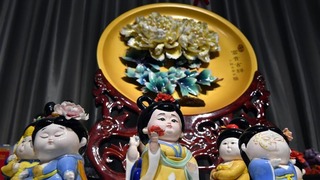The Second Age of Luoyang
Shang dynasty ca 1600-1050 BCE
The Shang dynasty that followed was, like the Xia, cloaked in legend until peasants near Anyang in northern Henan began digging up bones with mysterious notches carved into them. Presuming them to be the bones of dragons, they were sold for use in traditional Chinese medicine. In 1899, they came into the hands of an antique dealer who recognised what they were. In 1928, after years of pillaging, an official excavation belatedly began. The site turned out to be the capital of the later Shang.The bones had been oracle bones, carved with primitive characters-the precursors to modern Chinese script-by diviners. Many of these early scribes left their identity enabling archaeologists to piece together the history of the Shang. It proved that the Han Dynasty historian Sima Qian had been startlingly accurate when he wrote about thirty Shang emperors, though we still don't know what sources he'd had. Unearthed pottery, bronze vessels, polished mirrors and weapons suggest just how sophisticated Shang society was well over one thousand years before Christ.
Recently, the Chinese Academy of Sciences has conducted archaeological surveys in Luoyang's Yanshi township that suggest Luoyang too had been the site of a major Shang settlement, identified as the earliest Shang capital of Xibo. According to traditional historical sources, 'Tang the Perfect founded Xibo after overthrowing the ived ruler Jie and defeating the ruling Xia dynasty. Archaeological finds suggest that the Shang walled city in Yangshi can be dated back to about 1600 BCE and it had a history of about 200 years as an ancient capital.

